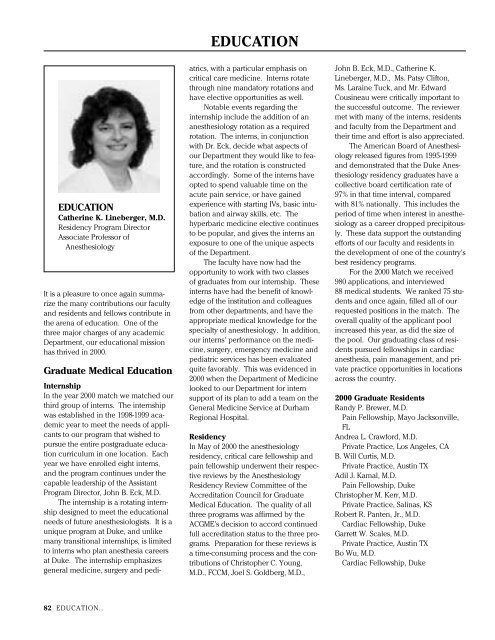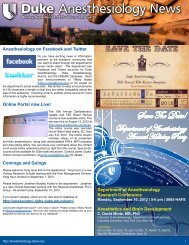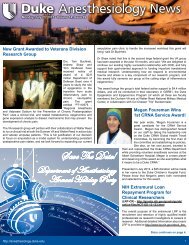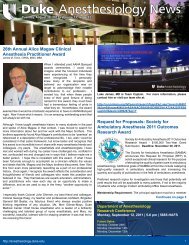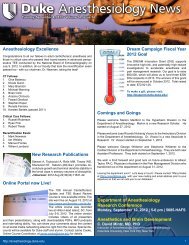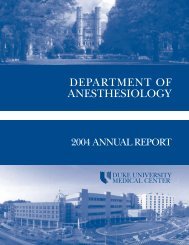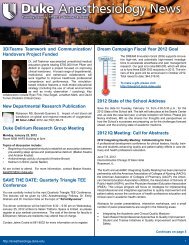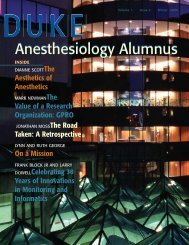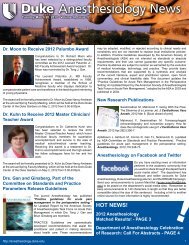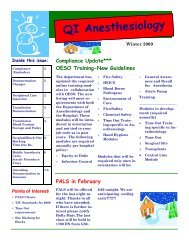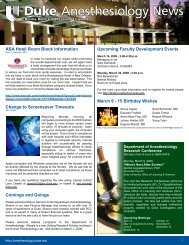DEPARTMENT OF ANESTHESIOLOGY ANNUAL REPORT
DEPARTMENT OF ANESTHESIOLOGY ANNUAL REPORT
DEPARTMENT OF ANESTHESIOLOGY ANNUAL REPORT
You also want an ePaper? Increase the reach of your titles
YUMPU automatically turns print PDFs into web optimized ePapers that Google loves.
EDUCATION<br />
Catherine K. Lineberger, M.D.<br />
Residency Program Director<br />
Associate Professor of<br />
Anesthesiology<br />
It is a pleasure to once again summarize<br />
the many contributions our faculty<br />
and residents and fellows contribute in<br />
the arena of education. One of the<br />
three major charges of any academic<br />
Department, our educational mission<br />
has thrived in 2000.<br />
Graduate Medical Education<br />
Internship<br />
In the year 2000 match we matched our<br />
third group of interns. The internship<br />
was established in the 1998-1999 academic<br />
year to meet the needs of applicants<br />
to our program that wished to<br />
pursue the entire postgraduate education<br />
curriculum in one location. Each<br />
year we have enrolled eight interns,<br />
and the program continues under the<br />
capable leadership of the Assistant<br />
Program Director, John B. Eck, M.D.<br />
The internship is a rotating internship<br />
designed to meet the educational<br />
needs of future anesthesiologists. It is a<br />
unique program at Duke, and unlike<br />
many transitional internships, is limited<br />
to interns who plan anesthesia careers<br />
at Duke. The internship emphasizes<br />
general medicine, surgery and pedi-<br />
82 EDUCATION..<br />
EDUCATION<br />
atrics, with a particular emphasis on<br />
critical care medicine. Interns rotate<br />
through nine mandatory rotations and<br />
have elective opportunities as well.<br />
Notable events regarding the<br />
internship include the addition of an<br />
anesthesiology rotation as a required<br />
rotation. The interns, in conjunction<br />
with Dr. Eck, decide what aspects of<br />
our Department they would like to feature,<br />
and the rotation is constructed<br />
accordingly. Some of the interns have<br />
opted to spend valuable time on the<br />
acute pain service, or have gained<br />
experience with starting IVs, basic intubation<br />
and airway skills, etc. The<br />
hyperbaric medicine elective continues<br />
to be popular, and gives the interns an<br />
exposure to one of the unique aspects<br />
of the Department.<br />
The faculty have now had the<br />
opportunity to work with two classes<br />
of graduates from our internship. These<br />
interns have had the benefit of knowledge<br />
of the institution and colleagues<br />
from other departments, and have the<br />
appropriate medical knowledge for the<br />
specialty of anesthesiology. In addition,<br />
our interns' performance on the medicine,<br />
surgery, emergency medicine and<br />
pediatric services has been evaluated<br />
quite favorably. This was evidenced in<br />
2000 when the Department of Medicine<br />
looked to our Department for intern<br />
support of its plan to add a team on the<br />
General Medicine Service at Durham<br />
Regional Hospital.<br />
Residency<br />
In May of 2000 the anesthesiology<br />
residency, critical care fellowship and<br />
pain fellowship underwent their respective<br />
reviews by the Anesthesiology<br />
Residency Review Committee of the<br />
Accreditation Council for Graduate<br />
Medical Education. The quality of all<br />
three programs was affirmed by the<br />
ACGME's decision to accord continued<br />
full accreditation status to the three programs.<br />
Preparation for these reviews is<br />
a time-consuming process and the contributions<br />
of Christopher C. Young,<br />
M.D., FCCM, Joel S. Goldberg, M.D.,<br />
John B. Eck, M.D., Catherine K.<br />
Lineberger, M.D., Ms. Patsy Clifton,<br />
Ms. Laraine Tuck, and Mr. Edward<br />
Cousineau were critically important to<br />
the successful outcome. The reviewer<br />
met with many of the interns, residents<br />
and faculty from the Department and<br />
their time and effort is also appreciated.<br />
The American Board of Anesthesiology<br />
released figures from 1995-1999<br />
and demonstrated that the Duke Anesthesiology<br />
residency graduates have a<br />
collective board certification rate of<br />
97% in that time interval, compared<br />
with 81% nationally. This includes the<br />
period of time when interest in anesthesiology<br />
as a career dropped precipitously.<br />
These data support the outstanding<br />
efforts of our faculty and residents in<br />
the development of one of the country's<br />
best residency programs.<br />
For the 2000 Match we received<br />
980 applications, and interviewed<br />
88 medical students. We ranked 75 students<br />
and once again, filled all of our<br />
requested positions in the match. The<br />
overall quality of the applicant pool<br />
increased this year, as did the size of<br />
the pool. Our graduating class of residents<br />
pursued fellowships in cardiac<br />
anesthesia, pain management, and private<br />
practice opportunities in locations<br />
across the country.<br />
2000 Graduate Residents<br />
Randy P. Brewer, M.D.<br />
Pain Fellowship, Mayo Jacksonville,<br />
FL<br />
Andrea L. Crawford, M.D.<br />
Private Practice, Los Angeles, CA<br />
B. Will Curtis, M.D.<br />
Private Practice, Austin TX<br />
Adil J. Kamal, M.D.<br />
Pain Fellowship, Duke<br />
Christopher M. Kerr, M.D.<br />
Private Practice, Salinas, KS<br />
Robert R. Panten, Jr., M.D.<br />
Cardiac Fellowship, Duke<br />
Garrett W. Scales, M.D.<br />
Private Practice, Austin TX<br />
Bo Wu, M.D.<br />
Cardiac Fellowship, Duke


